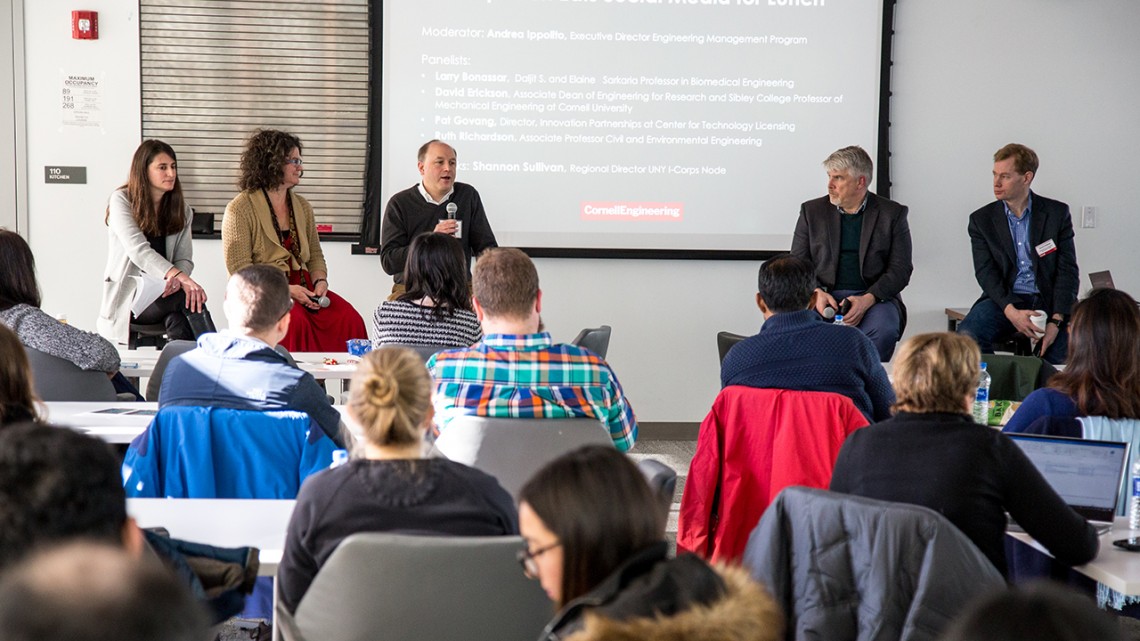
From left, Andrea Ippolito ’06, M.Eng ’07, executive director of the Engineering Management Program; Ruth Richardson, associate professor of civil and environmental engineering; Larry Bonassar, the Daljit S. and Elaine Sarkaria Professor in Biomedical Engineering in the Meinig School of Biomedical Engineering and the Sibley School of Mechanical and Aerospace Engineering; Patrick Govang, director of innovation partnerships at the Center for Technology Licensing; and David Erickson, associate dean of engineering for research and the Sibley College Professor of Mechanical Engineering, speak at the “Deep Tech Eats Social Media for Lunch” panel, held Jan. 28 in the Upson Hall lounge.
‘Deep tech’ innovations require industry partnerships
By Melanie Lefkowitz
Deep tech – a term referring to potentially momentous scientific breakthroughs – has the power to change the world. But because it can be complex, abstract, expensive and slow, innovators often struggle to find the funding to take their ideas to the next level.
Creating new opportunities for industry partnerships and increasing engagement with the world beyond the lab could help researchers make a broader impact and meet grand challenges, said speakers at the “Deep Tech Eats Social Media for Lunch” panel, held Jan. 28 in the Upson Hall lounge.
“As we all know, venture capitalists are often investing in safe software technology [rather] than more ‘moonshot’ and more ambitious ventures,” said Andrea Ippolito ’06, M.Eng ’07, executive director of the Engineering Management Program, who moderated the panel. “But a piece of software alone won’t remove CO2 from the atmosphere, it won’t tackle the complex challenges we face with infrastructure issues in this country and abroad, it won’t develop new diagnostic or therapeutic tools to deal with pancreatic cancer, and it won’t help deal with the water quality issues or incredible water shortage issue that we’re facing across this world.
“Deep tech is all about tackling these gnarly complex challenges that have huge potential for impact,” she said.
The panel was part of the “Deep Tech Takeover,” sponsored by the College of Engineering and the Center for Regional Economic Advancement to showcase entrepreneurship training and funding opportunities for deep tech researchers. For example, speakers said, the NSF I-Corps provides funding to learn from potential customers and develop new technologies that meet market needs and benefit society.
“It’s very easy to sit in your lab and imagine your technology being useful, but it’s very difficult to actually ensure it is something useful,” said David Erickson, associate dean of engineering for research and the Sibley College Professor of Mechanical Engineering. “I think the key to making that happen is better engagement.”
Ruth Richardson, associate professor of civil and environmental engineering, said that working with the New York State Parks Department on her work on water-monitoring technologies brought her a better understanding of what kind of research was needed.
“For me the big thing is feeling like my research could have a lot more impact than simply publishing, presenting and managing a graduate program,” she said.
Supporting researchers during the early stages is key, panelists said, as deep tech can take a long time to develop and may not have an obvious market at first.
“It takes a longer time to build these technologies out, and you need to take a longer view,” said Patrick Govang, director of innovation partnerships at the Center for Technology Licensing.
For example, Facebook, now at its 15-year mark, has paid back its initial investors many times over and created billions in value. By comparison, a world-changing innovation in the steel industry in the 1970s and 1980s, which increased profit margins from 3-5 percent to 20 percent, took more than 15 years and lots more capital comparatively before it could effectively transform that industry, Govang said.
Support for the local business infrastructure would also help, he said, because it could entice more startups growing out of Cornell to remain in the region and fuel Ithaca’s growing entrepreneur community.
“One of the ways I think about this is finding ways to make the area more sticky, for lack of a better word, both for people and for companies,” said Larry Bonassar, the Daljit S. and Elaine Sarkaria Professor in Biomedical Engineering in the Meinig School of Biomedical Engineering and the Sibley School of Mechanical and Aerospace Engineering. A startup that grew out of his lab decided to stay in the region “in part because of the access – both the proximity to campus and all that entailed, and the access to the local talent pool,” he said.
Existing programs at Cornell, such as CTL, are already helping bridge the divide between academic research and commercialization, he said.
The panelists agreed that talking to everyone from industry professionals to the potential beneficiaries of a new technology not only makes connections, but it inspires new ideas and questions that lead to better science.
“As engineers we like to make things, and hopefully we like to make things that are useful, so if you can connect with people and engage with the process it really forces you to think about what you’re making, how it’s going to be used and how you can make a better piece of technology,” Bonassar said. “Resources from industry – both intellectual and financial – are key to how my lab works.”
Media Contact
Get Cornell news delivered right to your inbox.
Subscribe
